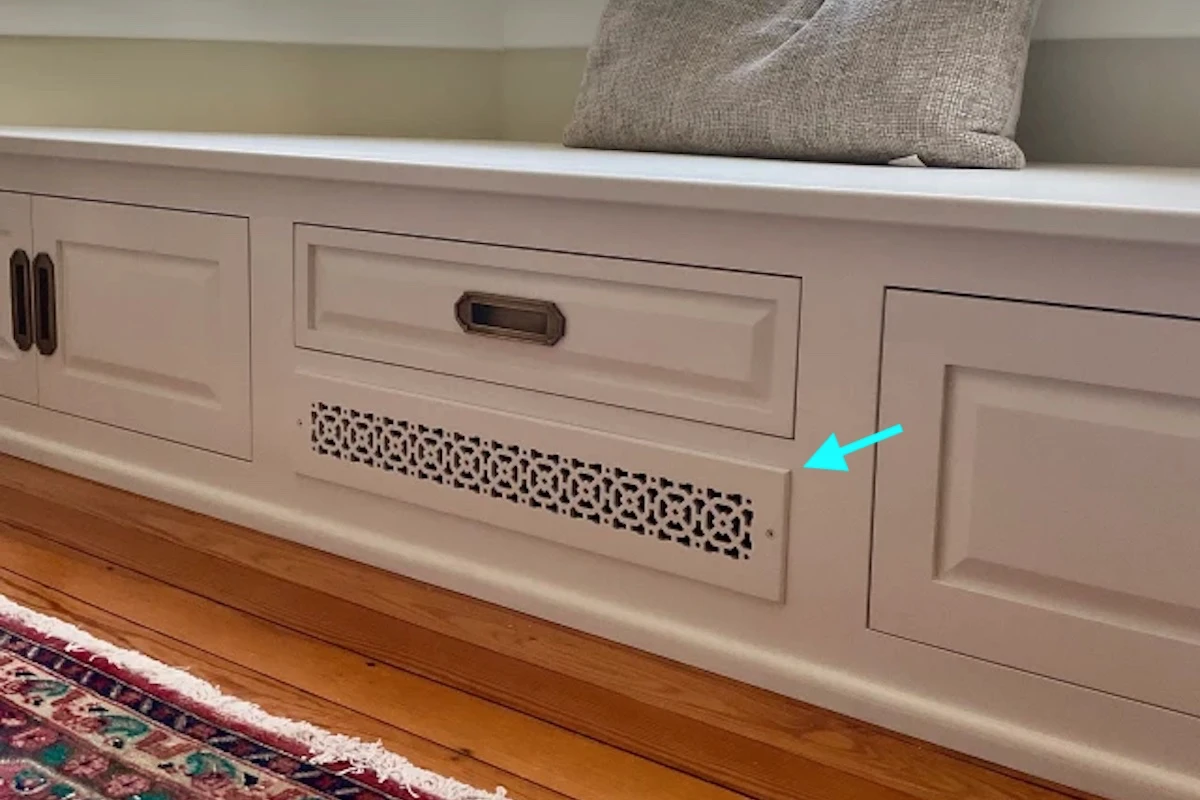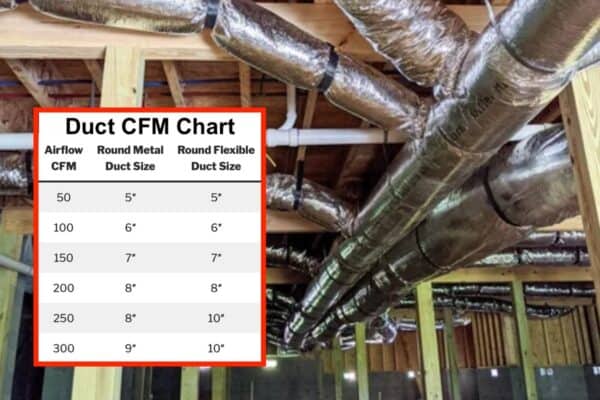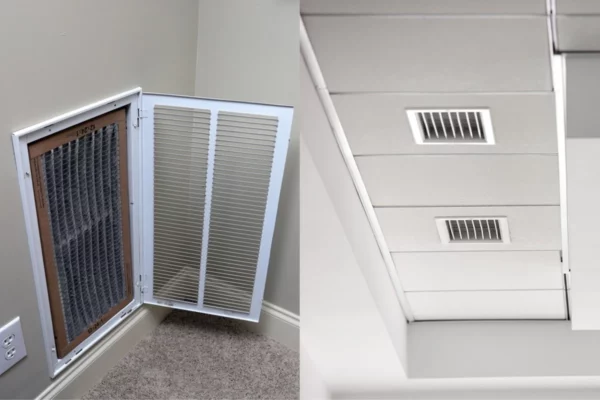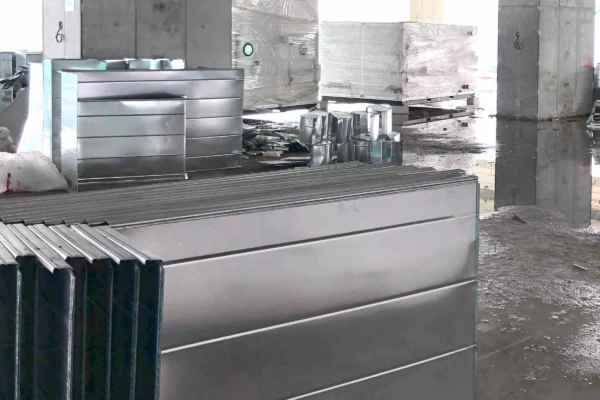Return Air Vent Cover: How to Do It Properly?
Many homeowners find their home HVAC return air vents ugly and thus, they want to cover up their return air vents to improve their home interior aesthetics. But, the question is how do you ensure that your return air vents are still working properly after you’ve covered them up?
To properly cover a return air vent, the free area of the decorative material must match the free area of the return air vent. At the same time, it should not cause the air velocity to increase too much as the return air vent will produce whistling noise.
Return air vents are not rocket science. Non-technical people and homeowners can definitely do it right. Just a little background understanding of how return air vents work can help you make things right once and for all.
- What is a Return Air Vent?
- Is a Return Air Vent Necessary?
- What Happens If There Is No Return Air Vent?
- Is It Okay to Block a Return Air Vent?
- Should Every Room Have a Return Air Vent?
- Where Should Return Air Vents Be Located?
- Return Air Vent Space Clearance
- Return Air Vent Cover Decorative Ideas
- How to Check If Your Return Air Vents Are Working Properly?
- Final Thought
What is a Return Air Vent?
A return air vent is a piece of HVAC equipment that serves as the final assembly of a return air system.
HVAC units such as a central air handler and a gas furnace need a return air system to be able to cool/heat the house. As the same air within the house repeatedly cycles through the HVAC unit, the temperature of the house can be reduced/increased.
In the return air system, there is a return air duct that connects to the HVAC unit. We called it the inlet side or the suction side. A return air vent is installed at the other end of the return air duct to serve as a decorative material and prevent foreign objects from entering the return air duct.
Sometimes, a return air vent may include an insect screen which is a fine mesh that blocks insects and bugs. This type of return air vent is usually used when installed at the exterior wall, taking in outside air.
Is a Return Air Vent Necessary?
In an HVAC system, return air vents are technically not required. But, without a return air vent, there will be a large opening on your side wall, floor or ceiling.
A central air handler or gas furnace does not cool/heat the air in your house instantaneously. Instead, it continuously circulates the air in your house through its cooling coil or heat exchanger which results in a gradual decrease/increase of the air temperature.
Hence, a return air vent is necessary to seal the HVAC system.
Sometimes, a return air vent is not necessary. When an air conditioning unit is pulling 100% outside air, a return air vent is not necessary. However, that’s not the case for 99% of the home HVAC system. These 100% outside air HVAC unit is mostly used in commercial buildings.
What Happens If There Is No Return Air Vent?
Every air handler and gas furnace has a fan and the fan has to pull air from the return air vent in order to supply cold/warm air through the supply air vents. If there is no return air duct or return air vent, the air handler or gas furnace will suffocate, leading to cooling/heating performance issues.
When a fan or an air handler or a gas furnace does not have sufficient return air, the power consumption will increase as the HVAC unit struggles to maintain the desired room temperature.
Another possible cause of not having a return air vent is your HVAC unit will pull air from somewhere else. It could be the air in the attic where the HVAC unit is located at. When this happens, your HVAC unit will use more power to cool the warm air.
Is It Okay to Block a Return Air Vent?
Instead of removing your return air vent, you may be thinking of blocking it with a decorative material or furniture. However, you may end up suffocating your HVAC unit.
But, if your house has many return air vents, it is okay to block one or two vents.
Most central air systems have a large return air vent in the middle of the house (like in the hallway or corridor area). If your HVAC unit only has one return air vent, blocking it will immediately suffocate the HVAC unit, leading to all sorts of performance issues.
Some houses have multiple return air vents. Specifically, one return air vent in every room (eg: bedroom, living room, hallway, etc.). If that’s the case, blocking one or two vents won’t harm the HVAC unit.
However, the HVAC system will cause a slight positive pressure in rooms that don’t have a return air vent. For instance, if the return air vent in the laundry room is blocked, the air pressure in the laundry room will increase by a little.
The air pressure increase due to the absence of a return air vent is barely noticeable. It is most obvious when you’re trying to open the door. You may notice that the door is slightly harder to open (push in).
When some return air vents in a house are blocked, other return air vents will simply suck in more airflow. However, you need to be careful not to block too many return air vents to a point where other return air vents start to produce whistling noise.
Partially Blocking a Return Air Vent
If a return air vent is partially blocked, the air pressure increase is also partial. However, the air velocity through that return air vent will increase and this may lead to it producing whistling noise.
Bottomline is, whether you’re completely blocking or partially blocking your return air vent, you must ensure that your HVAC unit is still receiving a sufficient amount of return air so that its performance does not deteriorate.
Fire Hazard
Blocking a return air vent can increase the risk of a fire hazard, especially if the HVAC unit is not properly maintained. You need to be cautious when dealing with old HVAC units (>10 years old).
Your HVAC unit relies on the return air to circulate the air in the room through the system and cool/heat it as needed. If the return air vent is blocked, the HVAC unit may not be able to circulate the air effectively, which can lead to the overheating of the system’s components.
When the HVAC unit is overheated, it can potentially cause a fire hazard, especially if there is a buildup of debris or dirt in the system that could catch fire.
Additionally, if the return air vent is blocked by flammable materials such as paper or cloth, these materials can catch fire if they come into contact with the hot components of the HVAC unit.
Fortunately, modern HVAC units have overheating protection. They’ll trip if their fan motor starts to heat up. Anyhow, you must ensure that your HVAC unit has sufficient return air no matter what.
Should Every Room Have a Return Air Vent?
If a return air vent is necessary and you can’t block it, how about optimizing the number of return air vents (reduce the quantity)? Hence, should every room have a return air vent?
List of rooms that should have a return air vent:
- Bedroom
- Living Room
- Study Room
- Hallway
- Home Office
- Sunroom
- Foyer
Ideally, every room should have a return air vent. This is to balance the air pressure when the doors are closed. If the doors are left open, the air will simply flow to the return air vent.
However, certain rooms should not have a return air vent. For instance, the bathroom shouldn’t have a return air vent as bacteria can be spread throughout the house by the HVAC system. In addition, the kitchen should not have a return air vent as the smell can spread across the house as well.
In addition, if the HVAC system relies on a return air temperature sensor for room temperature control instead of a traditional thermostat, then a return air vent is needed in every room. See why here: Does Every Bedroom Need a Cold Air Return Vent & Duct?
Otherwise, a return air vent is fine but the thermostat should be located in the same room as the return air vent to detect the average temperature of the house. Be careful not to put the thermostat too close to the return air vent as it may misinterpret the room temperature.
Where Should Return Air Vents Be Located?
If your HVAC system is designed to have one return air vent only, the return air vent should be located in the middle of the house to ensure it can pull air from all rooms.
On the flip side, if your HVAC system is designed to have multiple return air vents, then the location of the return air vents is more complicated.
Code for Return Air Vent
In the United States, the International Residential Code (IRC) is the building code for return air.
In accordance with the IRC 2018 Section M1602, a return air vent shall not be located less than 10 ft (3048 mm) measured in any direction from an open combustion chamber or draft hood of another appliance located in the same room or space.
Additionally, a return air vent is prohibited in the kitchen, except if the connected HVAC unit serves the kitchen only, and the return air vent shall be located more than 10 ft (3048 mm) away from the cooking appliances.
Floor vs Ceiling
Return air vents can be located either on the floor or the ceiling, depending on the specific design of the HVAC system and the layout of the building. However, floor-return air vents are more common in residential buildings, where they are often located in a central hallway or near the main living space.
Floor return air vents are typically located near the wall or in the floor joint space and are often covered with a vent grille or grate. They can help to draw in cool air from the lower part of the space, which can help to maintain a more comfortable temperature in the living space.
However, it is easier for hair, fur and other objects to go inside the floor-return air vents. But no worries, every HVAC unit has a filter that can trap these objects.
Floor-return air vents tend to need more decoration than ceiling-return air vents because they are more visible. Hence, many homeowners wish to cover up their floor vents.
Return Air Vent Space Clearance
If you want to cover up your return air vent without affecting the return airflow, it is generally recommended that you leave at least 6 inches of space clearance as shown in the below photo:
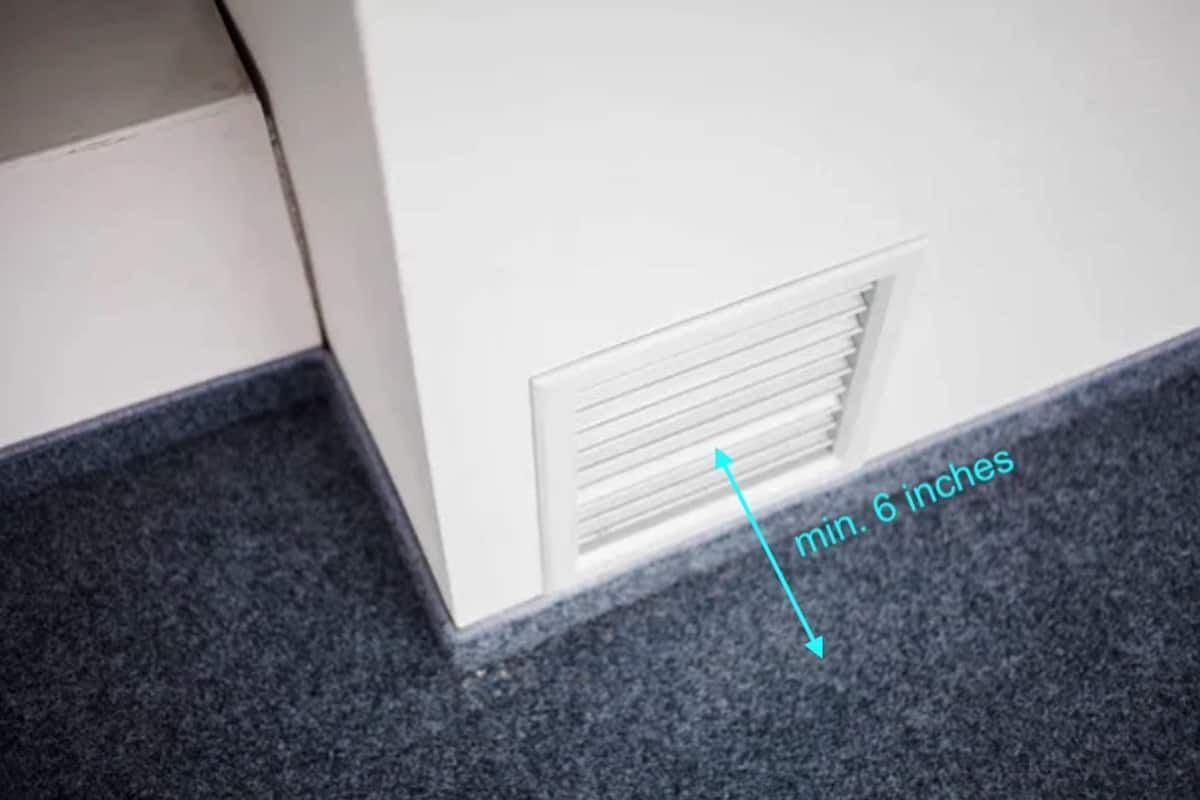
When space clearance is provided, the air has sufficient space to return through the return air vent. So, you’re blocking the view of the return air vent without affecting the performance of your HVAC system.
Return Air Vent Cover Decorative Ideas
If blocking the return air vent is not your primary choice, you may be thinking of a decorative vent cover. Here are some return air vent cover decorative ideas that probably won’t harm your HVAC system:
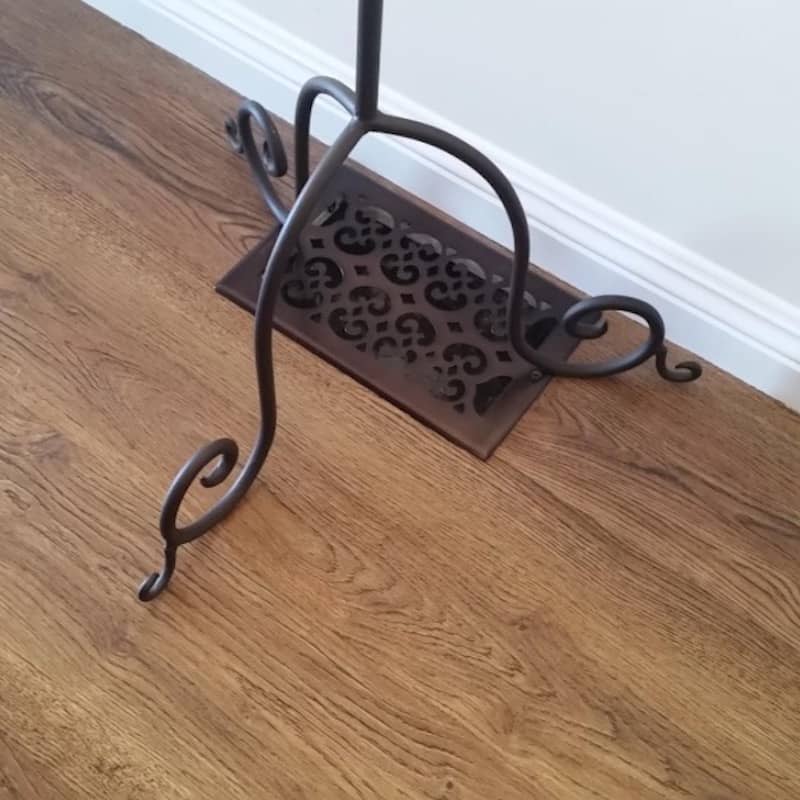
The Antique Brass Vent
For small vents (6×10, 6×12, 6×14), this antique brass-finished return air vent decorative grate can blend well with the rest of your furniture. It also comes in 3 other colors; bronze, gold and silver.
The Chinese Oriental Grate
From 2×12 to 6×14, this oriental-style grate is a beautiful decoration for your floor vent. It offers multiple colors that you surely can find one that suits the interior of your home.
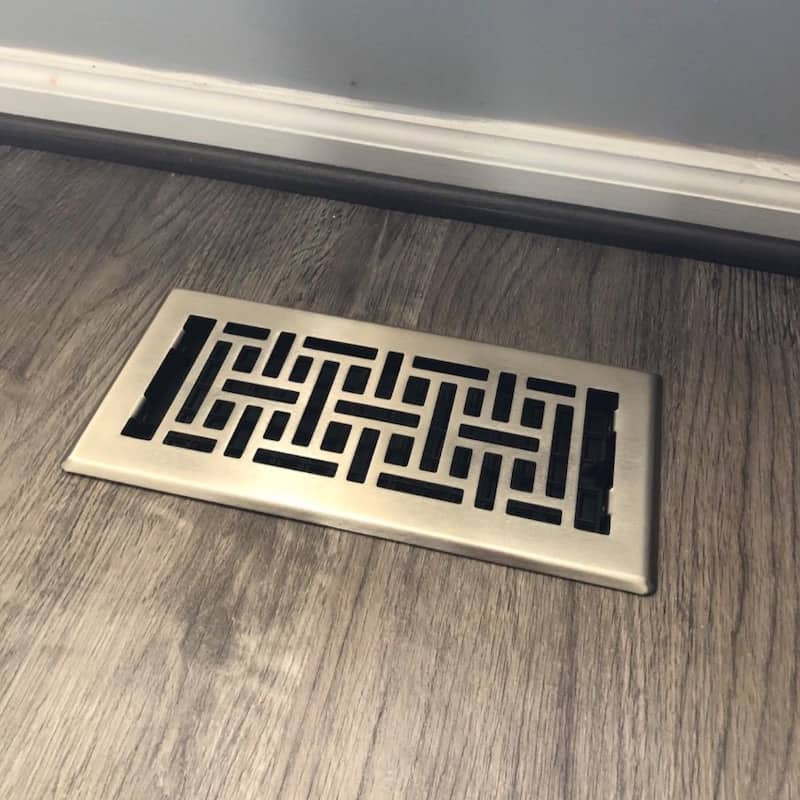
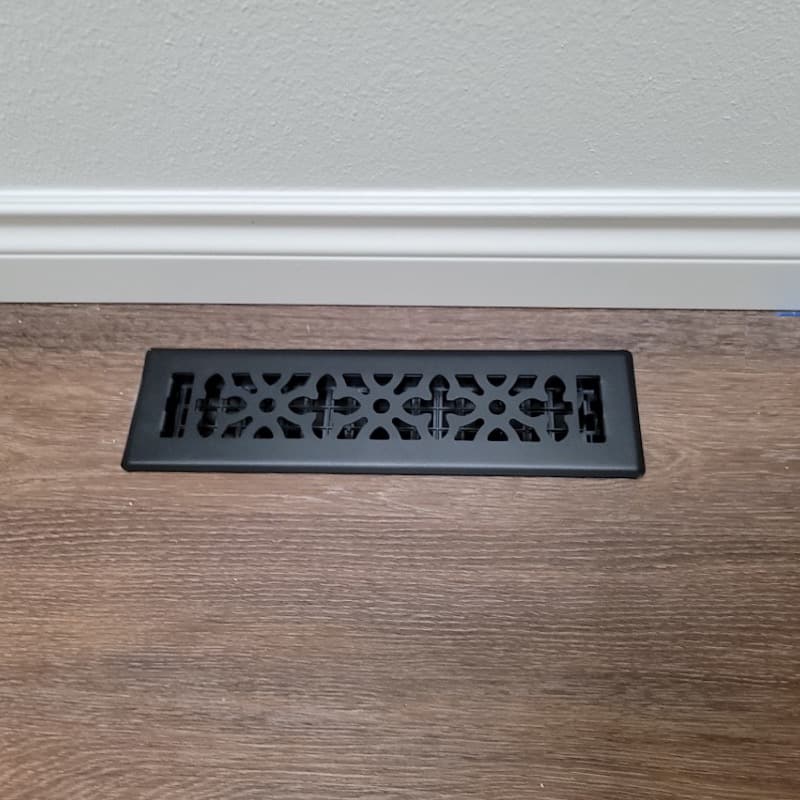
The Black Gothic Register
Up to 4×12, this black gothic floor register represents your attitude towards a balance of aesthetics and performance. Available in a variety of styles and finishes to match any decor.
The Cabinet Cover
A clever way to hide your return air vent is to put a cabinet in front of it. However, the cabinet needs to allow air to pass through and the mesh needs to be large enough to avoid whistling noise.
Decoration Idea by Eye For Design

For more return air vent decorative ideas, check out Pinterest.
How to Check If Your Return Air Vents Are Working Properly?
After you’ve covered up your return air vents, how do you know if your HVAC unit is still working properly? So, here are 3 tips to check your HVAC unit:
- Noise Level – Compare the noise at the return air vent before and after you cover it up. If the return air vent is significantly noisier after you cover it up, you might want to adjust the cover or use a smaller cover or a cover with a more free area so that your HVAC unit is not struggling to pull air.
- Cooling/Heating Performance – Feel the room temperature before and after you’ve covered the return air vent. If certain rooms feel not right, remove the cover and test again until you’ve satisfied with the performance of your HVAC system.
- Fan Amperage – Use a clamp meter to check the running current of your HVAC unit before and after you cover the return air vent. If your HVAC unit is suffocating, the amperage will increase and so does the power consumption.
Final Thought
HVAC return air vents can be ugly to some people. Return air vent covers need to be done properly in order not to affect the performance of the HVAC system. The important things to look out for when covering a return air vent are the noise level increase, cooling/heating performance drop and fan amperage increase. If those parameters are acceptable, you can then ensure that you’ve covered your return air vent properly.
Lastly, consider my Mini Split (eBook) if you want to know how can you use Mini Split in your house. If you still have doubt or not feeling confident enough, feel free to consult me.
Consultation Service
Ask me for HVAC advice such as brand selection, best model, benefits, features, placement, duct size, grille size, how to design, design check, verification and other HVAC related queries.
If you have anything to add (or ask) about this topic, leave a comment down below!


